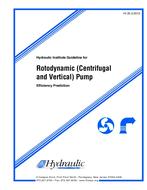Click here to purchase
This guideline presents a simple method that will help pump users predict normally attainable efficiency levels at the best efficiency point (BEP) for selected types of rotodynamic pumps when the rate of flow, total head per stage, net positive suction head available (NPSHA), and the service conditions are known.Graphs are used extensively to portray the relationship of pump efficiency versus different parameters
The following pump types are included in this guideline:
- Slurry, end suction
- Solids-handling, end suction pumps
- Submersible sewage, end suction
- Stock, end suction
- Horizontal multistage, axial split, segmented ring diffuser barrel
- ASME B73, API end suction, end suction- small
- End suction – large (greater than 0.3 m3/s (5000 gpm)
- API double suction
- Double suction, general service
- Vertical turbine, mixed-flow and propeller, single and multistage diffuser type
- Learn how surface roughness and internal pump clearances affect pump efficiency
- Understand the power consumption and efficiency loss created by bearings, lip seals, mechanical shaft seals, and shaft packing. Small, low horsepower pumps are particularly sensitive to these mechanical losses.
- The type of pumpage – viscosity, solids size and density, and slurries will have an influence on efficiency
- Special impeller designs, such as those intended to increase suction specific speed or provide a specific curve shape can reduce the attainable efficiency
- Thrust balance devices that are used to balance hydraulic thrust operate on the basis of differential pressure and bypass pump flow can reduce pump efficiency
- Multistage vertical turbine (diffuser) type pumps exhibit a difference between attainable bowl efficiency and attainable pump efficiency
Product Details
- Published:
- 2010
- ISBN(s):
- 1880952931
- ANSI:
- ANSI Approved
- Number of Pages:
- 26
- File Size:
- 1 file , 530 KB
